Supply Chain Management Analysis and Strategies at Sony Corporation
VerifiedAdded on 2023/06/12
|17
|4571
|169
Report
AI Summary
This report provides a comprehensive analysis of Sony Corporation's supply chain management, highlighting operational, informational, integration, and sustainability issues. It discusses the challenges Sony faces, such as supply chain disruptions due to natural disasters, restructuring, and demand forecasting difficulties exacerbated by the bullwhip effect. The report also explores Sony's procurement strategies, IT technology implementation (like RFID), and sustainability practices. Furthermore, it examines potential improvement programs to enhance the company's efficiency, agility, and overall supply chain performance, aligning with Sony's mission and vision. The analysis emphasizes the importance of addressing integration issues and adopting sustainable practices to ensure long-term success and competitiveness in the global market. Desklib is a platform where students can find similar solved assignments.
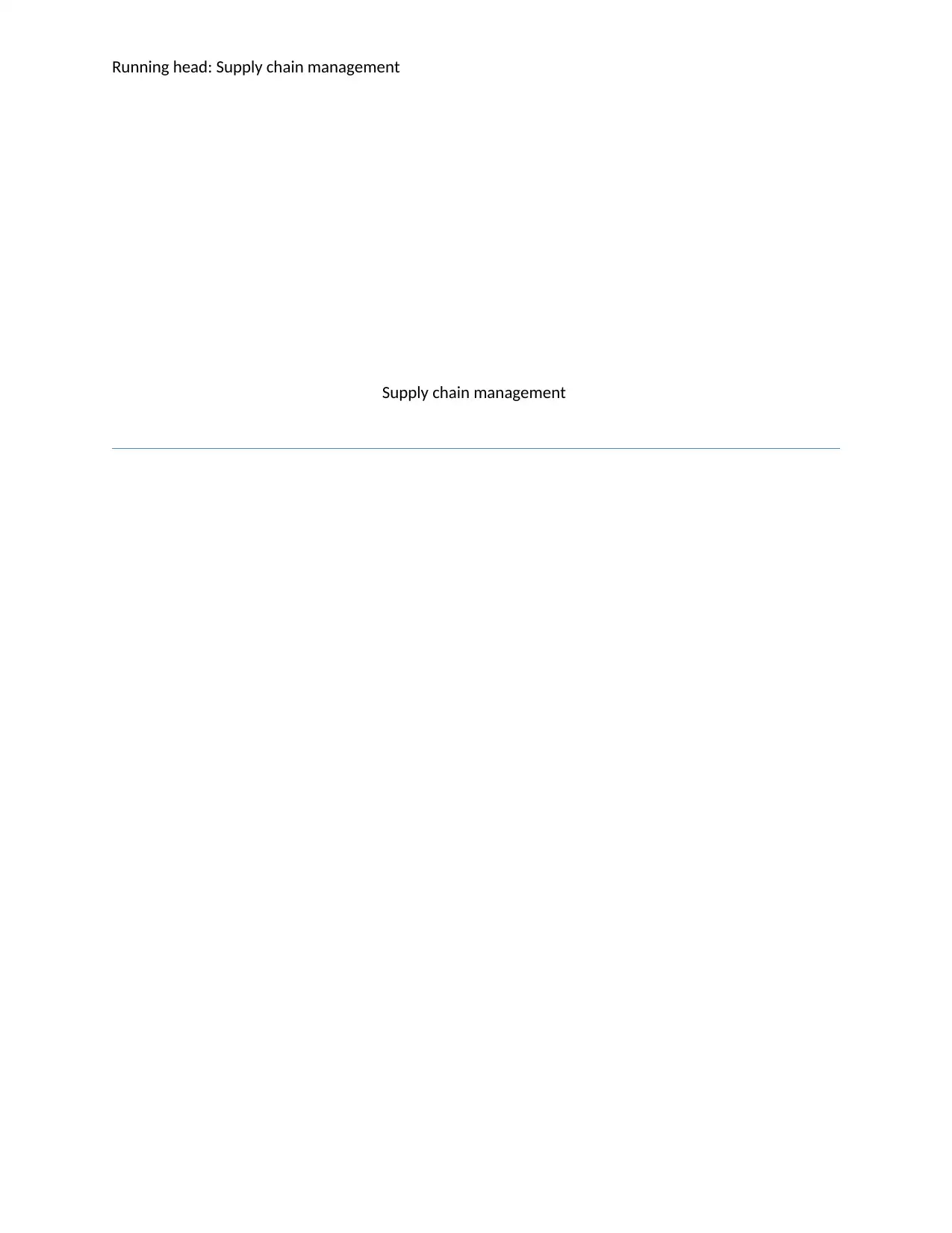
Running head: Supply chain management
Supply chain management
Supply chain management
Paraphrase This Document
Need a fresh take? Get an instant paraphrase of this document with our AI Paraphraser
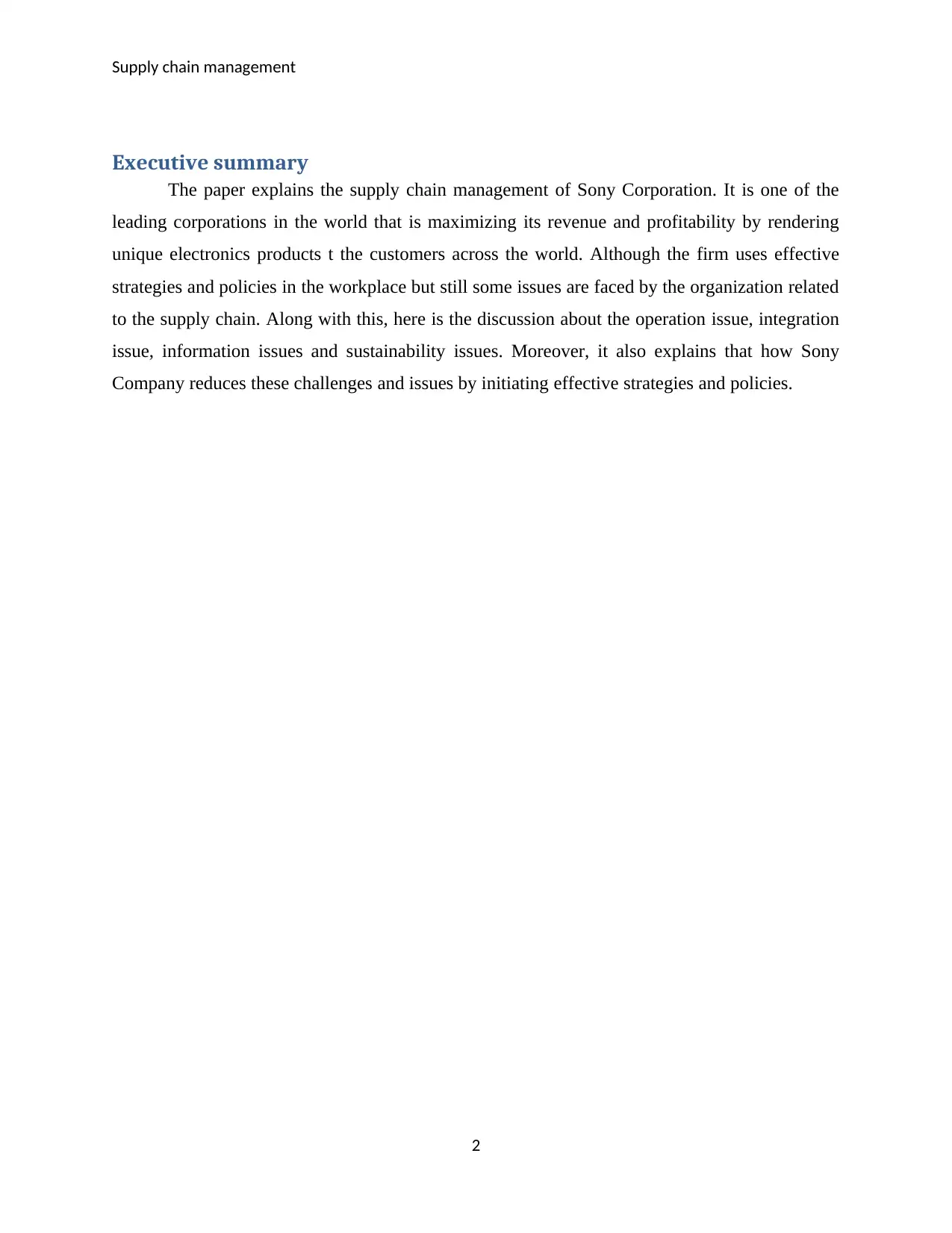
Supply chain management
Executive summary
The paper explains the supply chain management of Sony Corporation. It is one of the
leading corporations in the world that is maximizing its revenue and profitability by rendering
unique electronics products t the customers across the world. Although the firm uses effective
strategies and policies in the workplace but still some issues are faced by the organization related
to the supply chain. Along with this, here is the discussion about the operation issue, integration
issue, information issues and sustainability issues. Moreover, it also explains that how Sony
Company reduces these challenges and issues by initiating effective strategies and policies.
2
Executive summary
The paper explains the supply chain management of Sony Corporation. It is one of the
leading corporations in the world that is maximizing its revenue and profitability by rendering
unique electronics products t the customers across the world. Although the firm uses effective
strategies and policies in the workplace but still some issues are faced by the organization related
to the supply chain. Along with this, here is the discussion about the operation issue, integration
issue, information issues and sustainability issues. Moreover, it also explains that how Sony
Company reduces these challenges and issues by initiating effective strategies and policies.
2
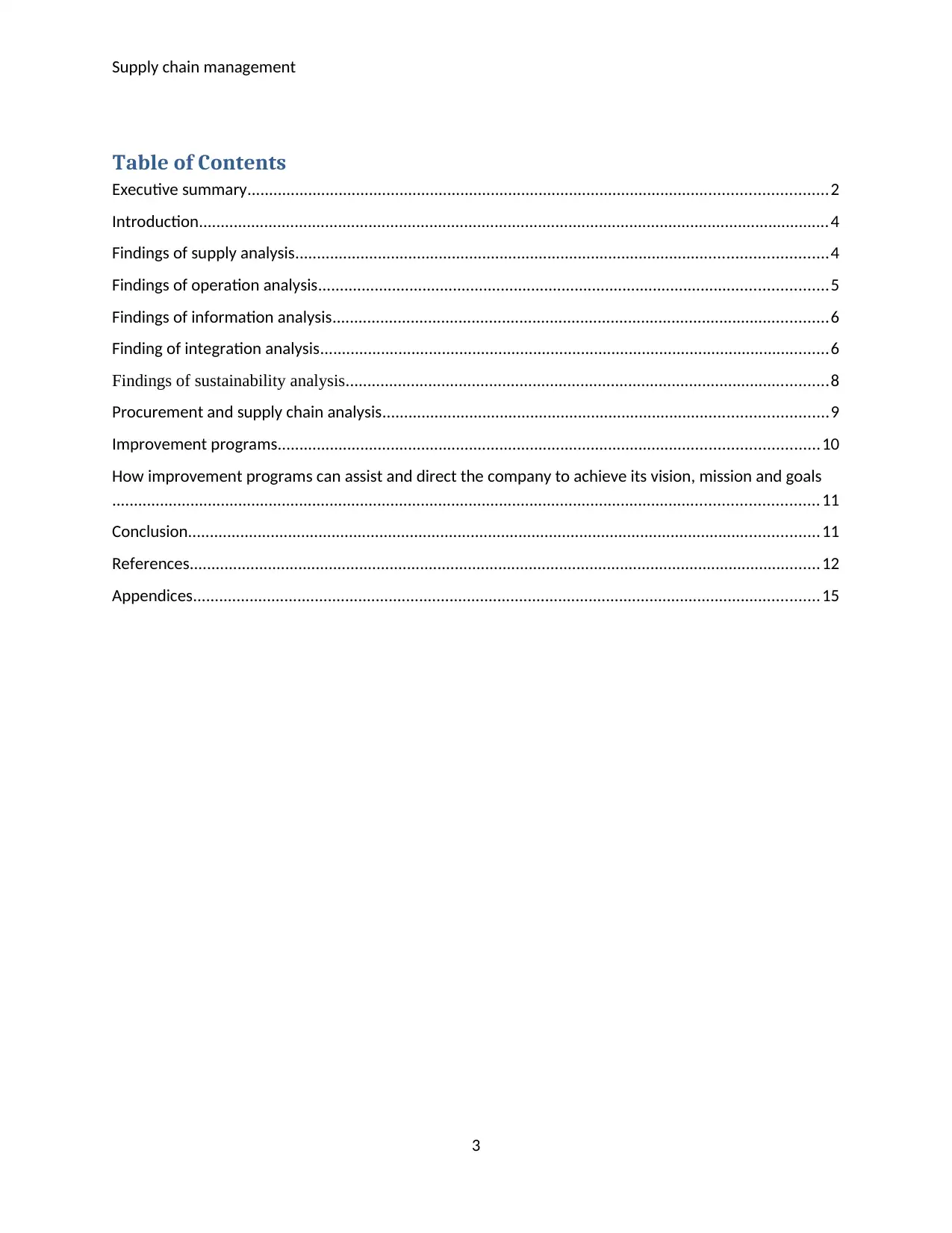
Supply chain management
Table of Contents
Executive summary.....................................................................................................................................2
Introduction.................................................................................................................................................4
Findings of supply analysis..........................................................................................................................4
Findings of operation analysis.....................................................................................................................5
Findings of information analysis..................................................................................................................6
Finding of integration analysis.....................................................................................................................6
Findings of sustainability analysis...............................................................................................................8
Procurement and supply chain analysis......................................................................................................9
Improvement programs............................................................................................................................10
How improvement programs can assist and direct the company to achieve its vision, mission and goals
.................................................................................................................................................................. 11
Conclusion.................................................................................................................................................11
References.................................................................................................................................................12
Appendices................................................................................................................................................15
3
Table of Contents
Executive summary.....................................................................................................................................2
Introduction.................................................................................................................................................4
Findings of supply analysis..........................................................................................................................4
Findings of operation analysis.....................................................................................................................5
Findings of information analysis..................................................................................................................6
Finding of integration analysis.....................................................................................................................6
Findings of sustainability analysis...............................................................................................................8
Procurement and supply chain analysis......................................................................................................9
Improvement programs............................................................................................................................10
How improvement programs can assist and direct the company to achieve its vision, mission and goals
.................................................................................................................................................................. 11
Conclusion.................................................................................................................................................11
References.................................................................................................................................................12
Appendices................................................................................................................................................15
3
⊘ This is a preview!⊘
Do you want full access?
Subscribe today to unlock all pages.

Trusted by 1+ million students worldwide
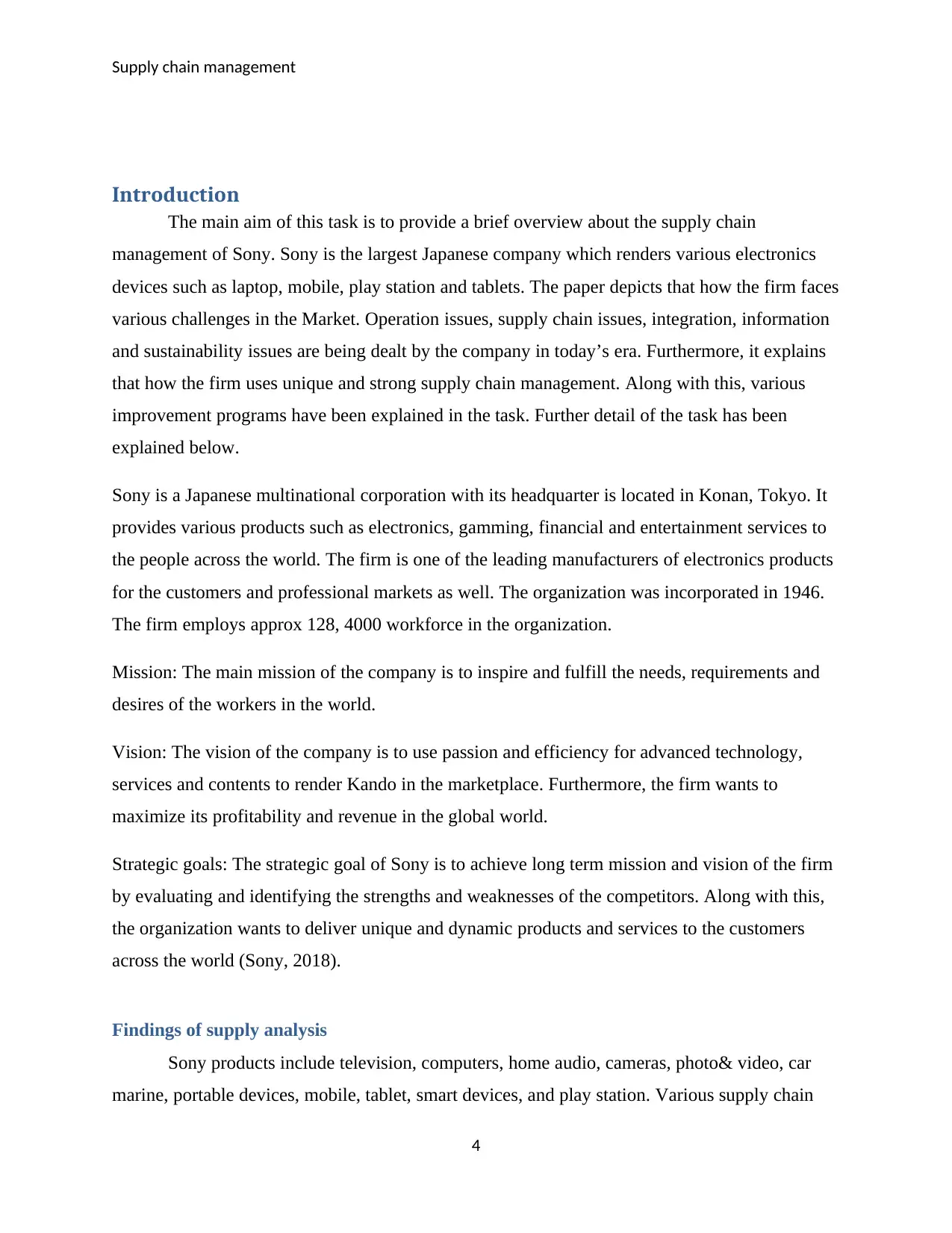
Supply chain management
Introduction
The main aim of this task is to provide a brief overview about the supply chain
management of Sony. Sony is the largest Japanese company which renders various electronics
devices such as laptop, mobile, play station and tablets. The paper depicts that how the firm faces
various challenges in the Market. Operation issues, supply chain issues, integration, information
and sustainability issues are being dealt by the company in today’s era. Furthermore, it explains
that how the firm uses unique and strong supply chain management. Along with this, various
improvement programs have been explained in the task. Further detail of the task has been
explained below.
Sony is a Japanese multinational corporation with its headquarter is located in Konan, Tokyo. It
provides various products such as electronics, gamming, financial and entertainment services to
the people across the world. The firm is one of the leading manufacturers of electronics products
for the customers and professional markets as well. The organization was incorporated in 1946.
The firm employs approx 128, 4000 workforce in the organization.
Mission: The main mission of the company is to inspire and fulfill the needs, requirements and
desires of the workers in the world.
Vision: The vision of the company is to use passion and efficiency for advanced technology,
services and contents to render Kando in the marketplace. Furthermore, the firm wants to
maximize its profitability and revenue in the global world.
Strategic goals: The strategic goal of Sony is to achieve long term mission and vision of the firm
by evaluating and identifying the strengths and weaknesses of the competitors. Along with this,
the organization wants to deliver unique and dynamic products and services to the customers
across the world (Sony, 2018).
Findings of supply analysis
Sony products include television, computers, home audio, cameras, photo& video, car
marine, portable devices, mobile, tablet, smart devices, and play station. Various supply chain
4
Introduction
The main aim of this task is to provide a brief overview about the supply chain
management of Sony. Sony is the largest Japanese company which renders various electronics
devices such as laptop, mobile, play station and tablets. The paper depicts that how the firm faces
various challenges in the Market. Operation issues, supply chain issues, integration, information
and sustainability issues are being dealt by the company in today’s era. Furthermore, it explains
that how the firm uses unique and strong supply chain management. Along with this, various
improvement programs have been explained in the task. Further detail of the task has been
explained below.
Sony is a Japanese multinational corporation with its headquarter is located in Konan, Tokyo. It
provides various products such as electronics, gamming, financial and entertainment services to
the people across the world. The firm is one of the leading manufacturers of electronics products
for the customers and professional markets as well. The organization was incorporated in 1946.
The firm employs approx 128, 4000 workforce in the organization.
Mission: The main mission of the company is to inspire and fulfill the needs, requirements and
desires of the workers in the world.
Vision: The vision of the company is to use passion and efficiency for advanced technology,
services and contents to render Kando in the marketplace. Furthermore, the firm wants to
maximize its profitability and revenue in the global world.
Strategic goals: The strategic goal of Sony is to achieve long term mission and vision of the firm
by evaluating and identifying the strengths and weaknesses of the competitors. Along with this,
the organization wants to deliver unique and dynamic products and services to the customers
across the world (Sony, 2018).
Findings of supply analysis
Sony products include television, computers, home audio, cameras, photo& video, car
marine, portable devices, mobile, tablet, smart devices, and play station. Various supply chain
4
Paraphrase This Document
Need a fresh take? Get an instant paraphrase of this document with our AI Paraphraser
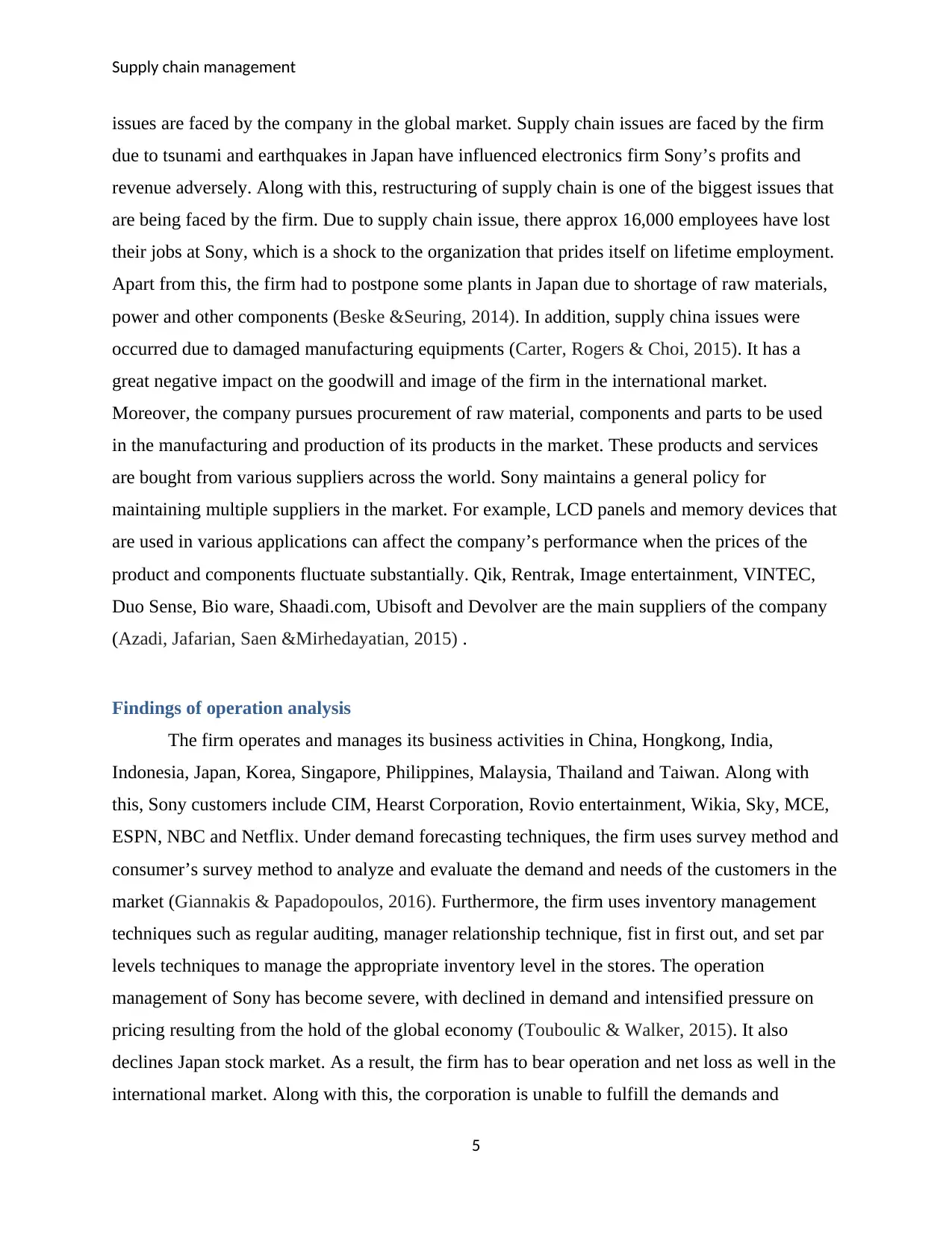
Supply chain management
issues are faced by the company in the global market. Supply chain issues are faced by the firm
due to tsunami and earthquakes in Japan have influenced electronics firm Sony’s profits and
revenue adversely. Along with this, restructuring of supply chain is one of the biggest issues that
are being faced by the firm. Due to supply chain issue, there approx 16,000 employees have lost
their jobs at Sony, which is a shock to the organization that prides itself on lifetime employment.
Apart from this, the firm had to postpone some plants in Japan due to shortage of raw materials,
power and other components (Beske &Seuring, 2014). In addition, supply china issues were
occurred due to damaged manufacturing equipments (Carter, Rogers & Choi, 2015). It has a
great negative impact on the goodwill and image of the firm in the international market.
Moreover, the company pursues procurement of raw material, components and parts to be used
in the manufacturing and production of its products in the market. These products and services
are bought from various suppliers across the world. Sony maintains a general policy for
maintaining multiple suppliers in the market. For example, LCD panels and memory devices that
are used in various applications can affect the company’s performance when the prices of the
product and components fluctuate substantially. Qik, Rentrak, Image entertainment, VINTEC,
Duo Sense, Bio ware, Shaadi.com, Ubisoft and Devolver are the main suppliers of the company
(Azadi, Jafarian, Saen &Mirhedayatian, 2015) .
Findings of operation analysis
The firm operates and manages its business activities in China, Hongkong, India,
Indonesia, Japan, Korea, Singapore, Philippines, Malaysia, Thailand and Taiwan. Along with
this, Sony customers include CIM, Hearst Corporation, Rovio entertainment, Wikia, Sky, MCE,
ESPN, NBC and Netflix. Under demand forecasting techniques, the firm uses survey method and
consumer’s survey method to analyze and evaluate the demand and needs of the customers in the
market (Giannakis & Papadopoulos, 2016). Furthermore, the firm uses inventory management
techniques such as regular auditing, manager relationship technique, fist in first out, and set par
levels techniques to manage the appropriate inventory level in the stores. The operation
management of Sony has become severe, with declined in demand and intensified pressure on
pricing resulting from the hold of the global economy (Touboulic & Walker, 2015). It also
declines Japan stock market. As a result, the firm has to bear operation and net loss as well in the
international market. Along with this, the corporation is unable to fulfill the demands and
5
issues are faced by the company in the global market. Supply chain issues are faced by the firm
due to tsunami and earthquakes in Japan have influenced electronics firm Sony’s profits and
revenue adversely. Along with this, restructuring of supply chain is one of the biggest issues that
are being faced by the firm. Due to supply chain issue, there approx 16,000 employees have lost
their jobs at Sony, which is a shock to the organization that prides itself on lifetime employment.
Apart from this, the firm had to postpone some plants in Japan due to shortage of raw materials,
power and other components (Beske &Seuring, 2014). In addition, supply china issues were
occurred due to damaged manufacturing equipments (Carter, Rogers & Choi, 2015). It has a
great negative impact on the goodwill and image of the firm in the international market.
Moreover, the company pursues procurement of raw material, components and parts to be used
in the manufacturing and production of its products in the market. These products and services
are bought from various suppliers across the world. Sony maintains a general policy for
maintaining multiple suppliers in the market. For example, LCD panels and memory devices that
are used in various applications can affect the company’s performance when the prices of the
product and components fluctuate substantially. Qik, Rentrak, Image entertainment, VINTEC,
Duo Sense, Bio ware, Shaadi.com, Ubisoft and Devolver are the main suppliers of the company
(Azadi, Jafarian, Saen &Mirhedayatian, 2015) .
Findings of operation analysis
The firm operates and manages its business activities in China, Hongkong, India,
Indonesia, Japan, Korea, Singapore, Philippines, Malaysia, Thailand and Taiwan. Along with
this, Sony customers include CIM, Hearst Corporation, Rovio entertainment, Wikia, Sky, MCE,
ESPN, NBC and Netflix. Under demand forecasting techniques, the firm uses survey method and
consumer’s survey method to analyze and evaluate the demand and needs of the customers in the
market (Giannakis & Papadopoulos, 2016). Furthermore, the firm uses inventory management
techniques such as regular auditing, manager relationship technique, fist in first out, and set par
levels techniques to manage the appropriate inventory level in the stores. The operation
management of Sony has become severe, with declined in demand and intensified pressure on
pricing resulting from the hold of the global economy (Touboulic & Walker, 2015). It also
declines Japan stock market. As a result, the firm has to bear operation and net loss as well in the
international market. Along with this, the corporation is unable to fulfill the demands and
5
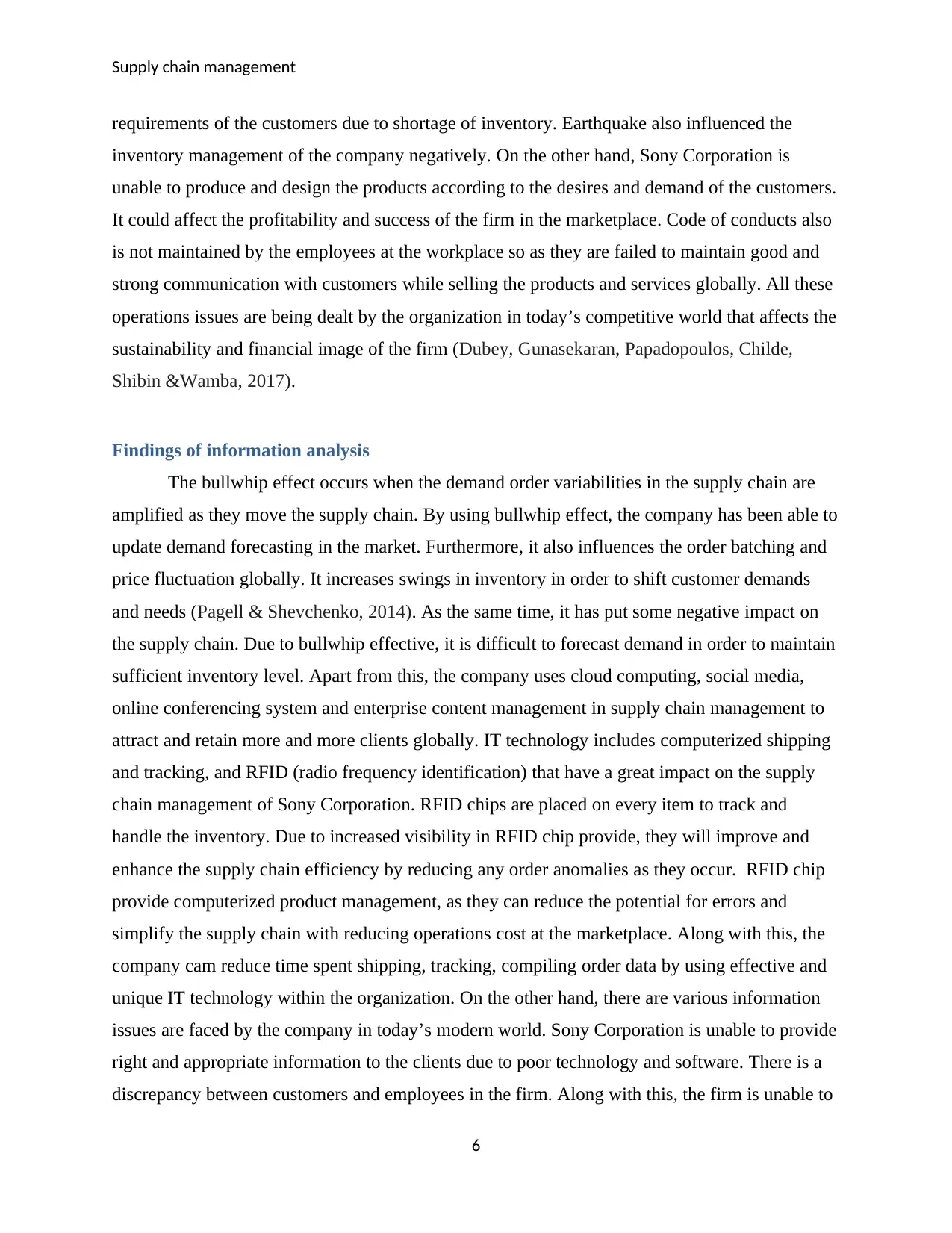
Supply chain management
requirements of the customers due to shortage of inventory. Earthquake also influenced the
inventory management of the company negatively. On the other hand, Sony Corporation is
unable to produce and design the products according to the desires and demand of the customers.
It could affect the profitability and success of the firm in the marketplace. Code of conducts also
is not maintained by the employees at the workplace so as they are failed to maintain good and
strong communication with customers while selling the products and services globally. All these
operations issues are being dealt by the organization in today’s competitive world that affects the
sustainability and financial image of the firm (Dubey, Gunasekaran, Papadopoulos, Childe,
Shibin &Wamba, 2017).
Findings of information analysis
The bullwhip effect occurs when the demand order variabilities in the supply chain are
amplified as they move the supply chain. By using bullwhip effect, the company has been able to
update demand forecasting in the market. Furthermore, it also influences the order batching and
price fluctuation globally. It increases swings in inventory in order to shift customer demands
and needs (Pagell & Shevchenko, 2014). As the same time, it has put some negative impact on
the supply chain. Due to bullwhip effective, it is difficult to forecast demand in order to maintain
sufficient inventory level. Apart from this, the company uses cloud computing, social media,
online conferencing system and enterprise content management in supply chain management to
attract and retain more and more clients globally. IT technology includes computerized shipping
and tracking, and RFID (radio frequency identification) that have a great impact on the supply
chain management of Sony Corporation. RFID chips are placed on every item to track and
handle the inventory. Due to increased visibility in RFID chip provide, they will improve and
enhance the supply chain efficiency by reducing any order anomalies as they occur. RFID chip
provide computerized product management, as they can reduce the potential for errors and
simplify the supply chain with reducing operations cost at the marketplace. Along with this, the
company cam reduce time spent shipping, tracking, compiling order data by using effective and
unique IT technology within the organization. On the other hand, there are various information
issues are faced by the company in today’s modern world. Sony Corporation is unable to provide
right and appropriate information to the clients due to poor technology and software. There is a
discrepancy between customers and employees in the firm. Along with this, the firm is unable to
6
requirements of the customers due to shortage of inventory. Earthquake also influenced the
inventory management of the company negatively. On the other hand, Sony Corporation is
unable to produce and design the products according to the desires and demand of the customers.
It could affect the profitability and success of the firm in the marketplace. Code of conducts also
is not maintained by the employees at the workplace so as they are failed to maintain good and
strong communication with customers while selling the products and services globally. All these
operations issues are being dealt by the organization in today’s competitive world that affects the
sustainability and financial image of the firm (Dubey, Gunasekaran, Papadopoulos, Childe,
Shibin &Wamba, 2017).
Findings of information analysis
The bullwhip effect occurs when the demand order variabilities in the supply chain are
amplified as they move the supply chain. By using bullwhip effect, the company has been able to
update demand forecasting in the market. Furthermore, it also influences the order batching and
price fluctuation globally. It increases swings in inventory in order to shift customer demands
and needs (Pagell & Shevchenko, 2014). As the same time, it has put some negative impact on
the supply chain. Due to bullwhip effective, it is difficult to forecast demand in order to maintain
sufficient inventory level. Apart from this, the company uses cloud computing, social media,
online conferencing system and enterprise content management in supply chain management to
attract and retain more and more clients globally. IT technology includes computerized shipping
and tracking, and RFID (radio frequency identification) that have a great impact on the supply
chain management of Sony Corporation. RFID chips are placed on every item to track and
handle the inventory. Due to increased visibility in RFID chip provide, they will improve and
enhance the supply chain efficiency by reducing any order anomalies as they occur. RFID chip
provide computerized product management, as they can reduce the potential for errors and
simplify the supply chain with reducing operations cost at the marketplace. Along with this, the
company cam reduce time spent shipping, tracking, compiling order data by using effective and
unique IT technology within the organization. On the other hand, there are various information
issues are faced by the company in today’s modern world. Sony Corporation is unable to provide
right and appropriate information to the clients due to poor technology and software. There is a
discrepancy between customers and employees in the firm. Along with this, the firm is unable to
6
⊘ This is a preview!⊘
Do you want full access?
Subscribe today to unlock all pages.

Trusted by 1+ million students worldwide
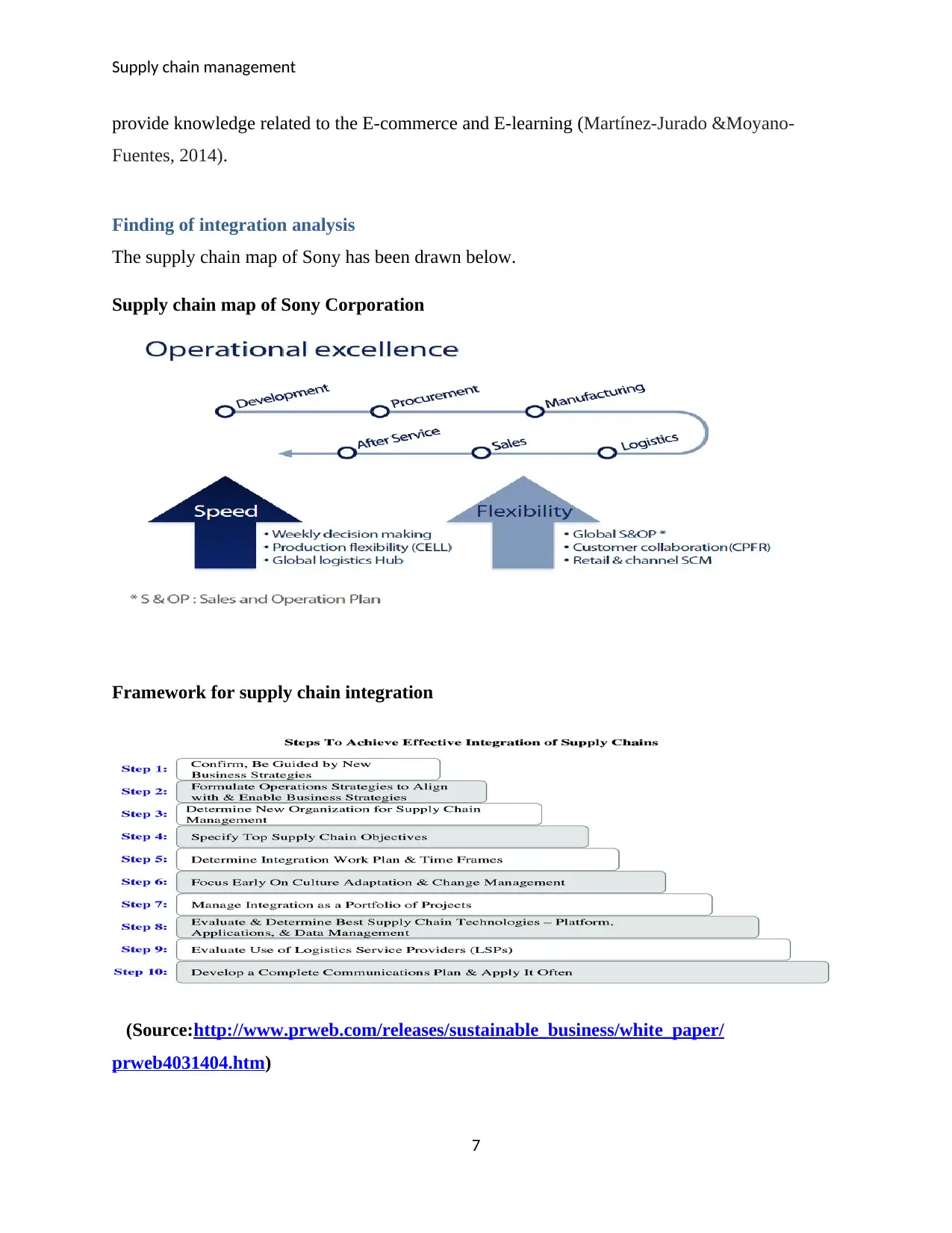
Supply chain management
provide knowledge related to the E-commerce and E-learning (Martínez-Jurado &Moyano-
Fuentes, 2014).
Finding of integration analysis
The supply chain map of Sony has been drawn below.
Supply chain map of Sony Corporation
Framework for supply chain integration
(Source:http://www.prweb.com/releases/sustainable_business/white_paper/
prweb4031404.htm)
7
provide knowledge related to the E-commerce and E-learning (Martínez-Jurado &Moyano-
Fuentes, 2014).
Finding of integration analysis
The supply chain map of Sony has been drawn below.
Supply chain map of Sony Corporation
Framework for supply chain integration
(Source:http://www.prweb.com/releases/sustainable_business/white_paper/
prweb4031404.htm)
7
Paraphrase This Document
Need a fresh take? Get an instant paraphrase of this document with our AI Paraphraser
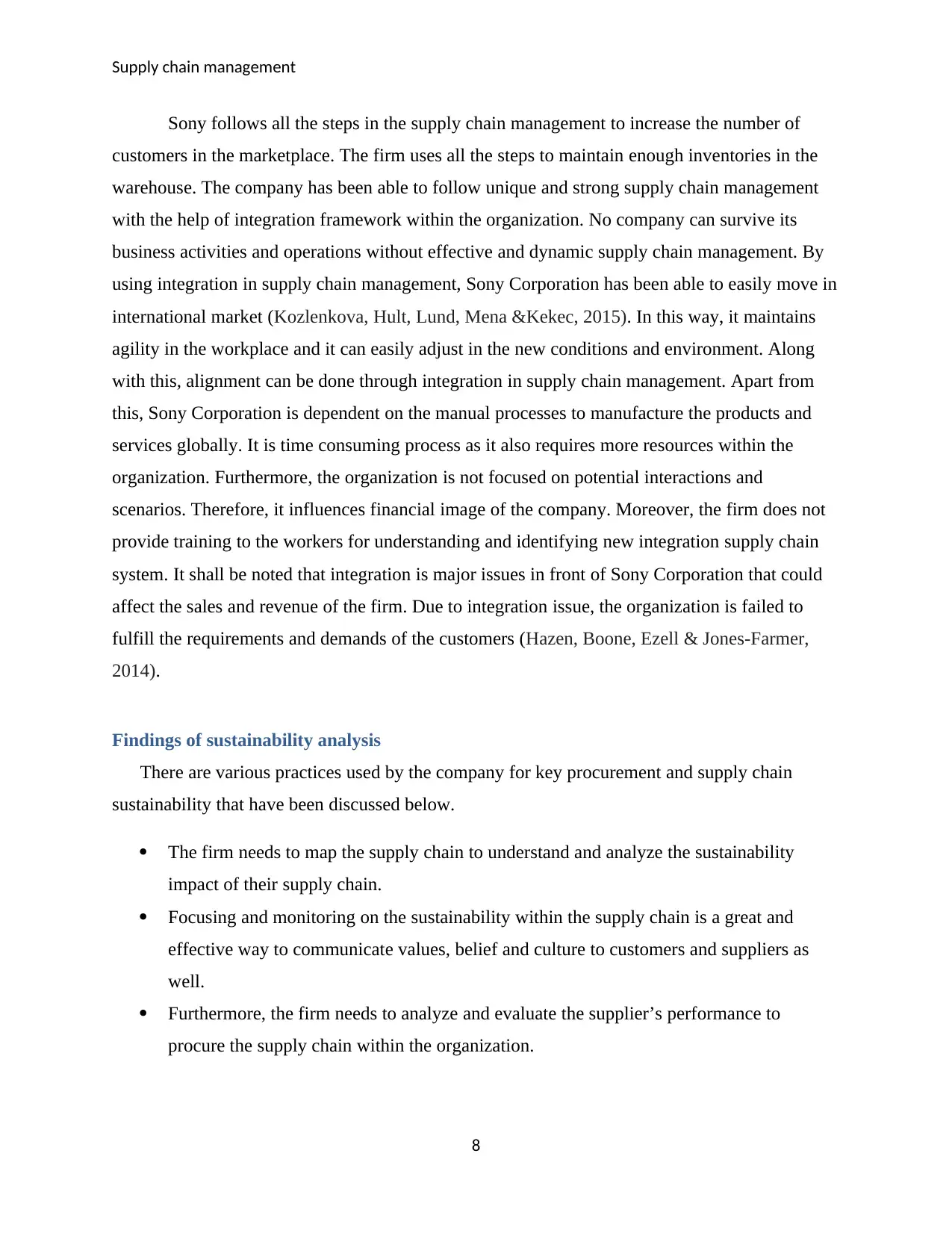
Supply chain management
Sony follows all the steps in the supply chain management to increase the number of
customers in the marketplace. The firm uses all the steps to maintain enough inventories in the
warehouse. The company has been able to follow unique and strong supply chain management
with the help of integration framework within the organization. No company can survive its
business activities and operations without effective and dynamic supply chain management. By
using integration in supply chain management, Sony Corporation has been able to easily move in
international market (Kozlenkova, Hult, Lund, Mena &Kekec, 2015). In this way, it maintains
agility in the workplace and it can easily adjust in the new conditions and environment. Along
with this, alignment can be done through integration in supply chain management. Apart from
this, Sony Corporation is dependent on the manual processes to manufacture the products and
services globally. It is time consuming process as it also requires more resources within the
organization. Furthermore, the organization is not focused on potential interactions and
scenarios. Therefore, it influences financial image of the company. Moreover, the firm does not
provide training to the workers for understanding and identifying new integration supply chain
system. It shall be noted that integration is major issues in front of Sony Corporation that could
affect the sales and revenue of the firm. Due to integration issue, the organization is failed to
fulfill the requirements and demands of the customers (Hazen, Boone, Ezell & Jones-Farmer,
2014).
Findings of sustainability analysis
There are various practices used by the company for key procurement and supply chain
sustainability that have been discussed below.
The firm needs to map the supply chain to understand and analyze the sustainability
impact of their supply chain.
Focusing and monitoring on the sustainability within the supply chain is a great and
effective way to communicate values, belief and culture to customers and suppliers as
well.
Furthermore, the firm needs to analyze and evaluate the supplier’s performance to
procure the supply chain within the organization.
8
Sony follows all the steps in the supply chain management to increase the number of
customers in the marketplace. The firm uses all the steps to maintain enough inventories in the
warehouse. The company has been able to follow unique and strong supply chain management
with the help of integration framework within the organization. No company can survive its
business activities and operations without effective and dynamic supply chain management. By
using integration in supply chain management, Sony Corporation has been able to easily move in
international market (Kozlenkova, Hult, Lund, Mena &Kekec, 2015). In this way, it maintains
agility in the workplace and it can easily adjust in the new conditions and environment. Along
with this, alignment can be done through integration in supply chain management. Apart from
this, Sony Corporation is dependent on the manual processes to manufacture the products and
services globally. It is time consuming process as it also requires more resources within the
organization. Furthermore, the organization is not focused on potential interactions and
scenarios. Therefore, it influences financial image of the company. Moreover, the firm does not
provide training to the workers for understanding and identifying new integration supply chain
system. It shall be noted that integration is major issues in front of Sony Corporation that could
affect the sales and revenue of the firm. Due to integration issue, the organization is failed to
fulfill the requirements and demands of the customers (Hazen, Boone, Ezell & Jones-Farmer,
2014).
Findings of sustainability analysis
There are various practices used by the company for key procurement and supply chain
sustainability that have been discussed below.
The firm needs to map the supply chain to understand and analyze the sustainability
impact of their supply chain.
Focusing and monitoring on the sustainability within the supply chain is a great and
effective way to communicate values, belief and culture to customers and suppliers as
well.
Furthermore, the firm needs to analyze and evaluate the supplier’s performance to
procure the supply chain within the organization.
8
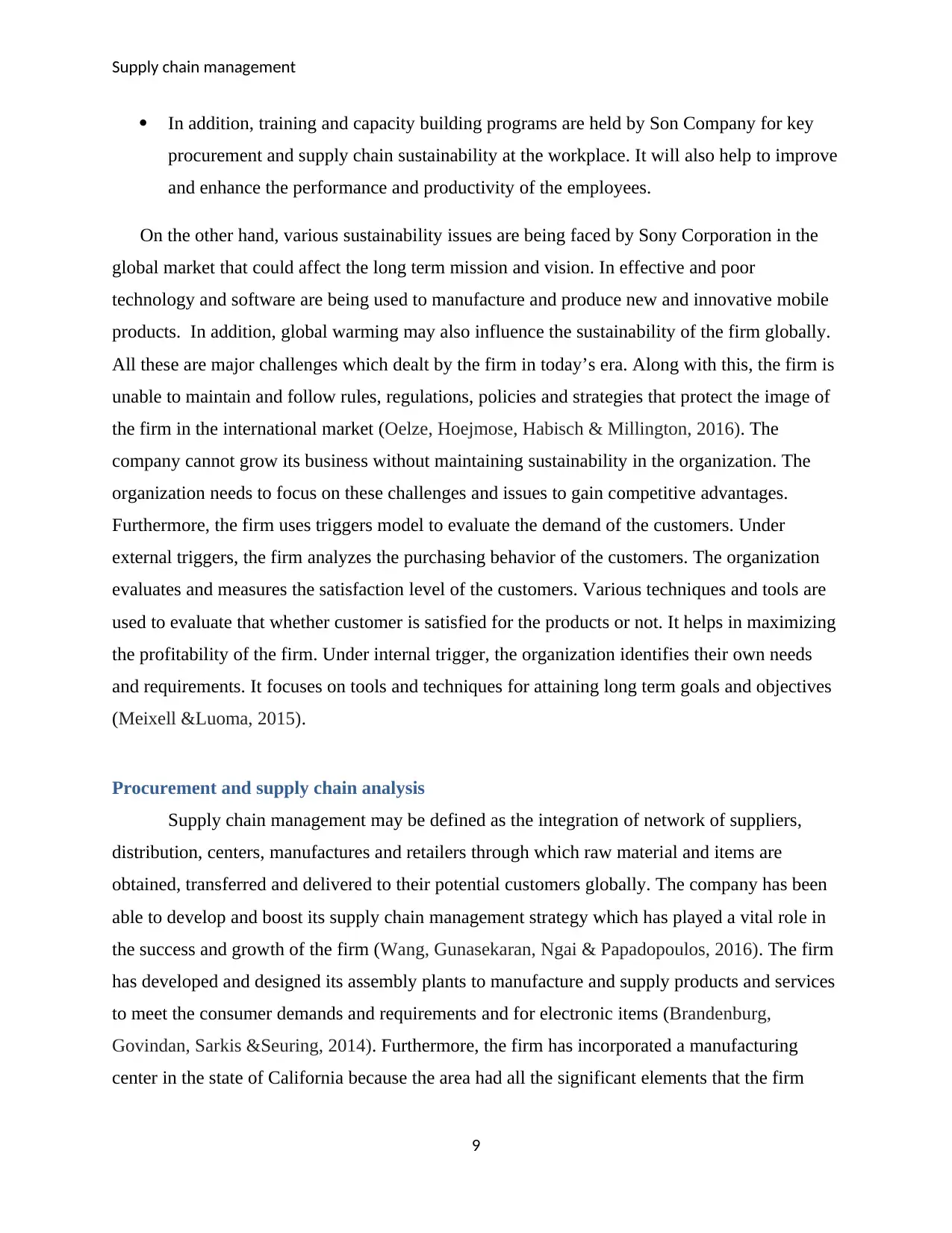
Supply chain management
In addition, training and capacity building programs are held by Son Company for key
procurement and supply chain sustainability at the workplace. It will also help to improve
and enhance the performance and productivity of the employees.
On the other hand, various sustainability issues are being faced by Sony Corporation in the
global market that could affect the long term mission and vision. In effective and poor
technology and software are being used to manufacture and produce new and innovative mobile
products. In addition, global warming may also influence the sustainability of the firm globally.
All these are major challenges which dealt by the firm in today’s era. Along with this, the firm is
unable to maintain and follow rules, regulations, policies and strategies that protect the image of
the firm in the international market (Oelze, Hoejmose, Habisch & Millington, 2016). The
company cannot grow its business without maintaining sustainability in the organization. The
organization needs to focus on these challenges and issues to gain competitive advantages.
Furthermore, the firm uses triggers model to evaluate the demand of the customers. Under
external triggers, the firm analyzes the purchasing behavior of the customers. The organization
evaluates and measures the satisfaction level of the customers. Various techniques and tools are
used to evaluate that whether customer is satisfied for the products or not. It helps in maximizing
the profitability of the firm. Under internal trigger, the organization identifies their own needs
and requirements. It focuses on tools and techniques for attaining long term goals and objectives
(Meixell &Luoma, 2015).
Procurement and supply chain analysis
Supply chain management may be defined as the integration of network of suppliers,
distribution, centers, manufactures and retailers through which raw material and items are
obtained, transferred and delivered to their potential customers globally. The company has been
able to develop and boost its supply chain management strategy which has played a vital role in
the success and growth of the firm (Wang, Gunasekaran, Ngai & Papadopoulos, 2016). The firm
has developed and designed its assembly plants to manufacture and supply products and services
to meet the consumer demands and requirements and for electronic items (Brandenburg,
Govindan, Sarkis &Seuring, 2014). Furthermore, the firm has incorporated a manufacturing
center in the state of California because the area had all the significant elements that the firm
9
In addition, training and capacity building programs are held by Son Company for key
procurement and supply chain sustainability at the workplace. It will also help to improve
and enhance the performance and productivity of the employees.
On the other hand, various sustainability issues are being faced by Sony Corporation in the
global market that could affect the long term mission and vision. In effective and poor
technology and software are being used to manufacture and produce new and innovative mobile
products. In addition, global warming may also influence the sustainability of the firm globally.
All these are major challenges which dealt by the firm in today’s era. Along with this, the firm is
unable to maintain and follow rules, regulations, policies and strategies that protect the image of
the firm in the international market (Oelze, Hoejmose, Habisch & Millington, 2016). The
company cannot grow its business without maintaining sustainability in the organization. The
organization needs to focus on these challenges and issues to gain competitive advantages.
Furthermore, the firm uses triggers model to evaluate the demand of the customers. Under
external triggers, the firm analyzes the purchasing behavior of the customers. The organization
evaluates and measures the satisfaction level of the customers. Various techniques and tools are
used to evaluate that whether customer is satisfied for the products or not. It helps in maximizing
the profitability of the firm. Under internal trigger, the organization identifies their own needs
and requirements. It focuses on tools and techniques for attaining long term goals and objectives
(Meixell &Luoma, 2015).
Procurement and supply chain analysis
Supply chain management may be defined as the integration of network of suppliers,
distribution, centers, manufactures and retailers through which raw material and items are
obtained, transferred and delivered to their potential customers globally. The company has been
able to develop and boost its supply chain management strategy which has played a vital role in
the success and growth of the firm (Wang, Gunasekaran, Ngai & Papadopoulos, 2016). The firm
has developed and designed its assembly plants to manufacture and supply products and services
to meet the consumer demands and requirements and for electronic items (Brandenburg,
Govindan, Sarkis &Seuring, 2014). Furthermore, the firm has incorporated a manufacturing
center in the state of California because the area had all the significant elements that the firm
9
⊘ This is a preview!⊘
Do you want full access?
Subscribe today to unlock all pages.

Trusted by 1+ million students worldwide
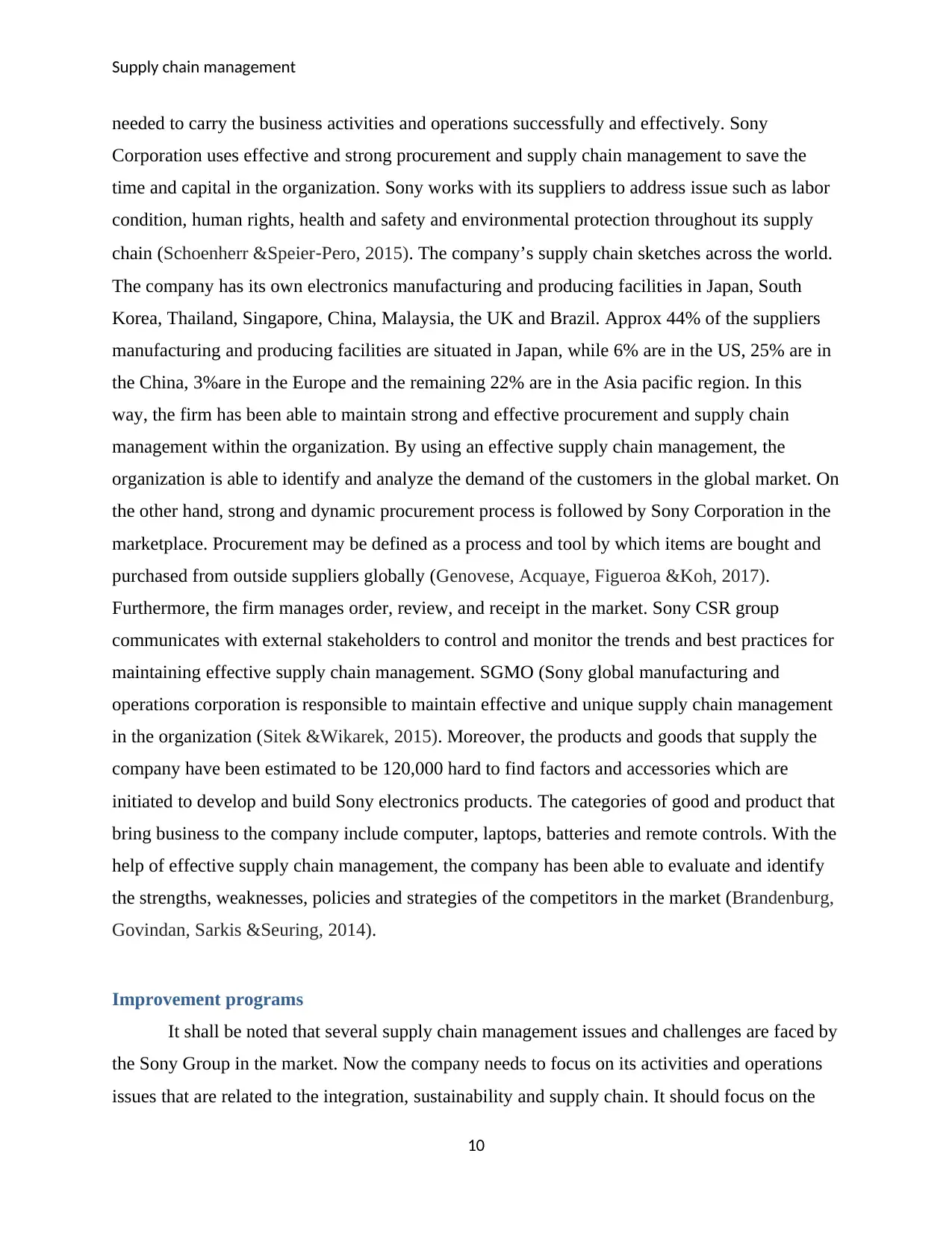
Supply chain management
needed to carry the business activities and operations successfully and effectively. Sony
Corporation uses effective and strong procurement and supply chain management to save the
time and capital in the organization. Sony works with its suppliers to address issue such as labor
condition, human rights, health and safety and environmental protection throughout its supply
chain (Schoenherr &Speier‐Pero, 2015). The company’s supply chain sketches across the world.
The company has its own electronics manufacturing and producing facilities in Japan, South
Korea, Thailand, Singapore, China, Malaysia, the UK and Brazil. Approx 44% of the suppliers
manufacturing and producing facilities are situated in Japan, while 6% are in the US, 25% are in
the China, 3%are in the Europe and the remaining 22% are in the Asia pacific region. In this
way, the firm has been able to maintain strong and effective procurement and supply chain
management within the organization. By using an effective supply chain management, the
organization is able to identify and analyze the demand of the customers in the global market. On
the other hand, strong and dynamic procurement process is followed by Sony Corporation in the
marketplace. Procurement may be defined as a process and tool by which items are bought and
purchased from outside suppliers globally (Genovese, Acquaye, Figueroa &Koh, 2017).
Furthermore, the firm manages order, review, and receipt in the market. Sony CSR group
communicates with external stakeholders to control and monitor the trends and best practices for
maintaining effective supply chain management. SGMO (Sony global manufacturing and
operations corporation is responsible to maintain effective and unique supply chain management
in the organization (Sitek &Wikarek, 2015). Moreover, the products and goods that supply the
company have been estimated to be 120,000 hard to find factors and accessories which are
initiated to develop and build Sony electronics products. The categories of good and product that
bring business to the company include computer, laptops, batteries and remote controls. With the
help of effective supply chain management, the company has been able to evaluate and identify
the strengths, weaknesses, policies and strategies of the competitors in the market (Brandenburg,
Govindan, Sarkis &Seuring, 2014).
Improvement programs
It shall be noted that several supply chain management issues and challenges are faced by
the Sony Group in the market. Now the company needs to focus on its activities and operations
issues that are related to the integration, sustainability and supply chain. It should focus on the
10
needed to carry the business activities and operations successfully and effectively. Sony
Corporation uses effective and strong procurement and supply chain management to save the
time and capital in the organization. Sony works with its suppliers to address issue such as labor
condition, human rights, health and safety and environmental protection throughout its supply
chain (Schoenherr &Speier‐Pero, 2015). The company’s supply chain sketches across the world.
The company has its own electronics manufacturing and producing facilities in Japan, South
Korea, Thailand, Singapore, China, Malaysia, the UK and Brazil. Approx 44% of the suppliers
manufacturing and producing facilities are situated in Japan, while 6% are in the US, 25% are in
the China, 3%are in the Europe and the remaining 22% are in the Asia pacific region. In this
way, the firm has been able to maintain strong and effective procurement and supply chain
management within the organization. By using an effective supply chain management, the
organization is able to identify and analyze the demand of the customers in the global market. On
the other hand, strong and dynamic procurement process is followed by Sony Corporation in the
marketplace. Procurement may be defined as a process and tool by which items are bought and
purchased from outside suppliers globally (Genovese, Acquaye, Figueroa &Koh, 2017).
Furthermore, the firm manages order, review, and receipt in the market. Sony CSR group
communicates with external stakeholders to control and monitor the trends and best practices for
maintaining effective supply chain management. SGMO (Sony global manufacturing and
operations corporation is responsible to maintain effective and unique supply chain management
in the organization (Sitek &Wikarek, 2015). Moreover, the products and goods that supply the
company have been estimated to be 120,000 hard to find factors and accessories which are
initiated to develop and build Sony electronics products. The categories of good and product that
bring business to the company include computer, laptops, batteries and remote controls. With the
help of effective supply chain management, the company has been able to evaluate and identify
the strengths, weaknesses, policies and strategies of the competitors in the market (Brandenburg,
Govindan, Sarkis &Seuring, 2014).
Improvement programs
It shall be noted that several supply chain management issues and challenges are faced by
the Sony Group in the market. Now the company needs to focus on its activities and operations
issues that are related to the integration, sustainability and supply chain. It should focus on the
10
Paraphrase This Document
Need a fresh take? Get an instant paraphrase of this document with our AI Paraphraser

Supply chain management
distribution and transportation system to address the issues and challenges. Green supply chain
management system is initiated by the firm to satisfy the clients and consumers. It should focus
on stakeholders to reduce and avert the sustainability issues at the workplace. It will also help to
beat the competitors in the firm (Govindan, Sarkis, Jabbour, Geng &Trandafir, 2017). Innovative
and advanced technologies shall be used by Sony to produce electronics products in the
marketplace. To gain competitive advantages, they should appoint a auditor and foreign
chairman to focus on the activities and operations of foreign market. In this way, the firm can
overcome on the supply chain issues (Schaltegger & Burritt, 2014). Apart from this, resource
based view theory is implemented by the company to optimize the resources effectively and
smoothly. It is also working on the green environment to reduce the negative impact of it. It
should also focus on the segmentation, targeting and positioning strategies to expand and explore
this business globally. The company should adopt a business operating model to avert and reduce
supply chain issues in the market. All these strategies help to build a good image in the market
(Ellram & Cooper, 2014).
How improvement programs can assist and direct the company to achieve its vision,
mission and goals
It shall be noted that Sony group can achieve its desired goals and objectives by focusing
on the supply chain management. Supply chain management helps in increasing the revenue and
outcomes in the international market. If the company is unable to follow unique supply chain
then it will affect the mission and vision of the corporation adversely. On the other hand, the
organization also monitors on the sustainability and information issues to gain competitive
benefits globally (Silvestre, 2015). The firm cannot attain sustainability without analyzing and
identifying the operations issues. Sony group makes unique strategies, policies and plans to deal
with operation issues. It will help in attaining long term output and hit the competitors in the
market. If the firm follows proper rules and policies then it can easily attain its vision and the
company can make an effective goodwill in the international market. Dynamic integration model
is used by the company to maintain sustainability and grow its business in the market.
Furthermore, if the organization provides right and appropriate information to the clients and
suppliers then it will help to improve and reduce the information issues within the organization.
It helps in boosting and developing loyalty, and trust among the customers. It also increases and
11
distribution and transportation system to address the issues and challenges. Green supply chain
management system is initiated by the firm to satisfy the clients and consumers. It should focus
on stakeholders to reduce and avert the sustainability issues at the workplace. It will also help to
beat the competitors in the firm (Govindan, Sarkis, Jabbour, Geng &Trandafir, 2017). Innovative
and advanced technologies shall be used by Sony to produce electronics products in the
marketplace. To gain competitive advantages, they should appoint a auditor and foreign
chairman to focus on the activities and operations of foreign market. In this way, the firm can
overcome on the supply chain issues (Schaltegger & Burritt, 2014). Apart from this, resource
based view theory is implemented by the company to optimize the resources effectively and
smoothly. It is also working on the green environment to reduce the negative impact of it. It
should also focus on the segmentation, targeting and positioning strategies to expand and explore
this business globally. The company should adopt a business operating model to avert and reduce
supply chain issues in the market. All these strategies help to build a good image in the market
(Ellram & Cooper, 2014).
How improvement programs can assist and direct the company to achieve its vision,
mission and goals
It shall be noted that Sony group can achieve its desired goals and objectives by focusing
on the supply chain management. Supply chain management helps in increasing the revenue and
outcomes in the international market. If the company is unable to follow unique supply chain
then it will affect the mission and vision of the corporation adversely. On the other hand, the
organization also monitors on the sustainability and information issues to gain competitive
benefits globally (Silvestre, 2015). The firm cannot attain sustainability without analyzing and
identifying the operations issues. Sony group makes unique strategies, policies and plans to deal
with operation issues. It will help in attaining long term output and hit the competitors in the
market. If the firm follows proper rules and policies then it can easily attain its vision and the
company can make an effective goodwill in the international market. Dynamic integration model
is used by the company to maintain sustainability and grow its business in the market.
Furthermore, if the organization provides right and appropriate information to the clients and
suppliers then it will help to improve and reduce the information issues within the organization.
It helps in boosting and developing loyalty, and trust among the customers. It also increases and
11
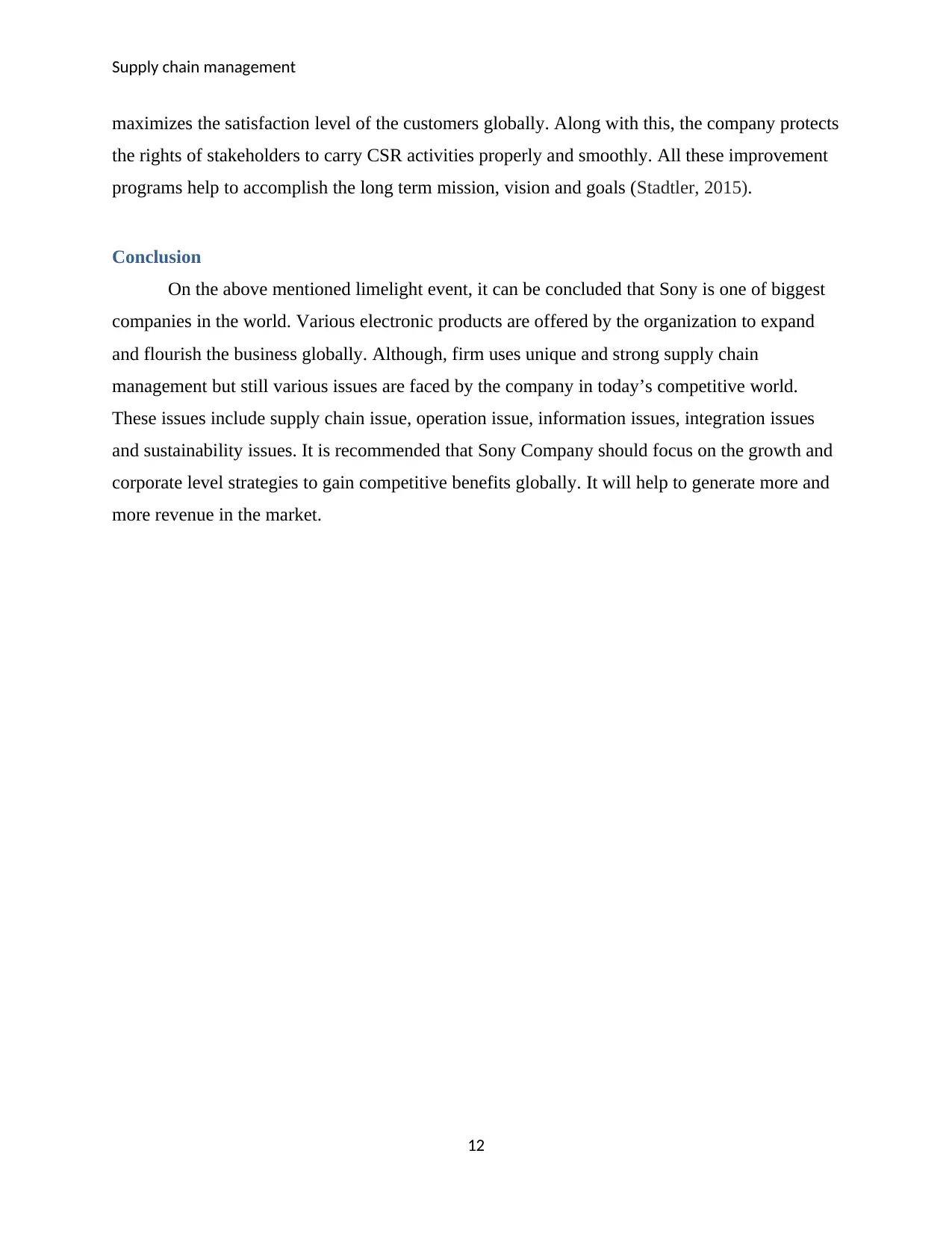
Supply chain management
maximizes the satisfaction level of the customers globally. Along with this, the company protects
the rights of stakeholders to carry CSR activities properly and smoothly. All these improvement
programs help to accomplish the long term mission, vision and goals (Stadtler, 2015).
Conclusion
On the above mentioned limelight event, it can be concluded that Sony is one of biggest
companies in the world. Various electronic products are offered by the organization to expand
and flourish the business globally. Although, firm uses unique and strong supply chain
management but still various issues are faced by the company in today’s competitive world.
These issues include supply chain issue, operation issue, information issues, integration issues
and sustainability issues. It is recommended that Sony Company should focus on the growth and
corporate level strategies to gain competitive benefits globally. It will help to generate more and
more revenue in the market.
12
maximizes the satisfaction level of the customers globally. Along with this, the company protects
the rights of stakeholders to carry CSR activities properly and smoothly. All these improvement
programs help to accomplish the long term mission, vision and goals (Stadtler, 2015).
Conclusion
On the above mentioned limelight event, it can be concluded that Sony is one of biggest
companies in the world. Various electronic products are offered by the organization to expand
and flourish the business globally. Although, firm uses unique and strong supply chain
management but still various issues are faced by the company in today’s competitive world.
These issues include supply chain issue, operation issue, information issues, integration issues
and sustainability issues. It is recommended that Sony Company should focus on the growth and
corporate level strategies to gain competitive benefits globally. It will help to generate more and
more revenue in the market.
12
⊘ This is a preview!⊘
Do you want full access?
Subscribe today to unlock all pages.

Trusted by 1+ million students worldwide
1 out of 17
Related Documents
Your All-in-One AI-Powered Toolkit for Academic Success.
+13062052269
info@desklib.com
Available 24*7 on WhatsApp / Email
![[object Object]](/_next/static/media/star-bottom.7253800d.svg)
Unlock your academic potential
Copyright © 2020–2025 A2Z Services. All Rights Reserved. Developed and managed by ZUCOL.




